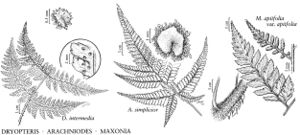Arachniodes simplicior
J. Jap. Bot. 37: 76. 1962.
Stems creeping, 5–8 mm diam., densely scaly; scales tan to brownish, lanceolate. Leaves monomorphic, evergreen, 40–85 cm. Petiole straw-colored to tan, spaced 0.5–4 cm apart, 15–46 cm × 4–6 mm, base scaly; scales lanceolate. Blade deltate-pentagonal, 2–3-pinnate, 24–40 cm, broadest at base, abruptly tapering distally, apex pinnate, ultimately pinnatifid, as long as or longer than rest of blade. Pinnae 3–5 pairs, 1-pinnate, proximal pair basally 2-pinnate, 8–18 × 2–4 cm (excluding expanded base of proximal pinnae). Basal pinnules of proximal pair of pinnae elongate and pinnalike; basiscopic pinnule to 10 cm, acroscopic pinnule 1/3–1/2 length of basiscopic. Ultimate segments undivided to pinnatifid, finely spiny along margins and at tip. Sori with indusia 0.5–1 mm diam., indusia with deep sinus and often overlapping lobes, glabrous.
Habitat: Terrestrial along stream banks in woods
Elevation: 0 m
Distribution

Introduced; S.C., Asia in Japan, China
Discussion
Arachniodes simplicior was introduced and naturalized in South Carolina and is known from a single population there (J. E. Gordon 1981). It was still locally common in April 1990 and apparently poses no threat to the native flora.
Selected References
None.
Lower Taxa
"broadest" is not a number."/3lengthofbasiscopic" is not declared as a valid unit of measurement for this property. "/2lengthofbasiscopic" is not declared as a valid unit of measurement for this property.
